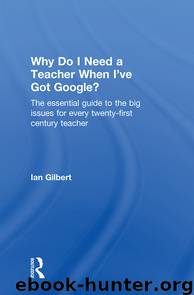Why Do I Need a Teacher When I’ve Got Google by Ian Gilbert

Author:Ian Gilbert [Gilbert, Ian]
Language: eng
Format: epub
Publisher: Taylor & Francis
Published: 2010-07-15T22:00:00+00:00
However, there was now a movement towards keeping little children away from the older ones, primarily so as not to disturb them. As decreed by the 1871 Committee of Council on Education in their Rules to be Observed in Planning and Fitting Up Schools, infants need to be taught in a different room ‘as the noise and the training of the infants disturb and injuriously affect the discipline and instruction of the older children’.
This was matched in the early nineteenth century by a call to have children interacting with the educated mind of a qualified teacher rather than printed or regurgitated material, something that, as it necessitated a more pedagogical approach, further underlined the need to separate children by age. The main protagonist behind this was another Scotsman, David Stow9 (someone to whom Samuel Wilderspin says, ‘much credit is due, for having written useful books and performed useful works,’ before adding rather pointedly, ‘I am not the man to deprive him of this his just due, but I have such faith in the honour of his countrymen in general, that I believe the time is not far distant when some one of them will give to me that credit which is fairly and justly due to me with respect to the educational movements in Scotland’). Stow felt the key to educational improvement was in better teacher training matched by dividing children into age divisions of two or three to six, six to eight or nine and nine to fourteen. This was further developed by a Professor J. J. Findlay in his 1902 publication Principles of Class Teaching, where he called for the age divisions to be set as infancy (birth to around four years of age); early childhood (four to six); later childhood (seven to nine); boy or girlhood (ten plus). It was also Professor Findlay who called for a clear break in schooling at age 11 between primary and secondary (Findlay 1902).
And, as they say, the rest, as they say, is history.
So, that’s how we ended up with the system we’ve got now, however the important question is does it work? Well, according to research I found for my foreword to Dave Harris’s book on transition, Dropping the Baton:
• 40 per cent of children lose motivation and make no progress during the year after transition.10
• Children who were making steady progress in primary school actually go backwards in the first year of secondary school.11
• There is a discontinuity between the primary and secondary curriculum, and a lack of information passing between schools relating to pupils’ abilities and existing achievements.12
• Teachers rarely identified children’s individual abilities as making a difference to the transition process, focusing instead on institutional initiatives, an emphasis that carries the risk of creating a degree of helplessness for individual pupils (Zeedyk et al. 2003).
Download
This site does not store any files on its server. We only index and link to content provided by other sites. Please contact the content providers to delete copyright contents if any and email us, we'll remove relevant links or contents immediately.
The Art of Coaching Workbook by Elena Aguilar(50859)
Trainspotting by Irvine Welsh(21486)
The Secret History by Donna Tartt(18805)
Twilight of the Idols With the Antichrist and Ecce Homo by Friedrich Nietzsche(18477)
All the Missing Girls by Megan Miranda(15491)
Cat's cradle by Kurt Vonnegut(15152)
Ready Player One by Cline Ernest(14493)
Talking to Strangers by Malcolm Gladwell(13185)
Fangirl by Rainbow Rowell(9068)
The remains of the day by Kazuo Ishiguro(8788)
The Compound Effect by Darren Hardy(8786)
Thirteen Reasons Why by Jay Asher(8767)
Tools of Titans by Timothy Ferriss(8186)
Periodization Training for Sports by Tudor Bompa(8145)
Wonder by R. J. Palacio(7974)
The Lover by Duras Marguerite(7805)
A Court of Wings and Ruin by Sarah J. Maas(7620)
Change Your Questions, Change Your Life by Marilee Adams(7610)
The Complete Stick Figure Physics Tutorials by Allen Sarah(7291)
